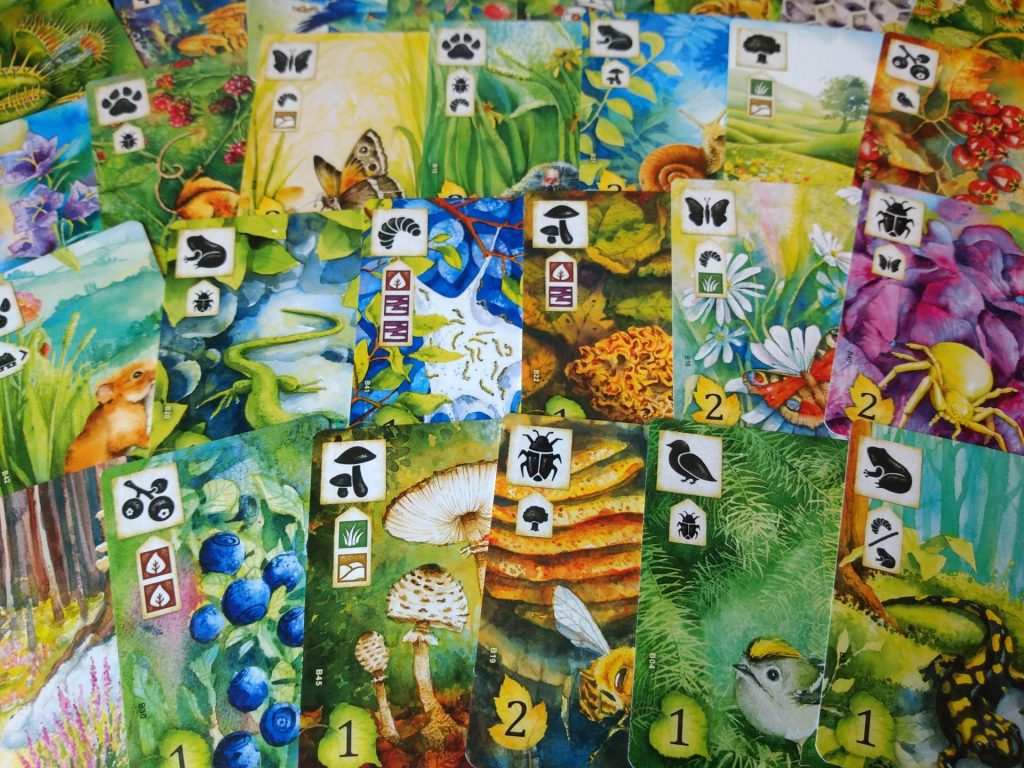Welcome to Volume 4 of Meeple Mountain’s ongoing collection of board game haiku. Yes, board game haiku are a thing. And yes, there are 3 previous collections of them, which you can find here: Volume 1, Volume 2 and Volume 3.
In discussing a board game we might cover a whole spectrum of elements, from the micro to the macro:
- What comes in the game box.
- How those rules and components combine with the players to produce the game itself.
- The game’s setting and theme.
- How effectively the game achieves its goals.
- The feelings the game invokes before, during and after play.
- Useful strategies and approaches for success.
- The place of the game within the designer’s and publisher’s portfolios.
- The impact the game has on, and its place within, the wider tabletop landscape.
Board game haiku are more limiting – there simply isn’t space across a mere 17 syllables to cover a game from every angle. Yet rather than being painfully restrictive, haiku are liberating, allowing the poet to shine a light on whichever aspect of the game most inspires them.
The haiku below cover all those elements listed above, sometimes addressing multiple aspects in one poem, sometimes focusing on just a single element. A few of them even fulfil the traditional principles of haiku: 5-7-5 syllables, a seasonal reference, a juxtaposition and a natural world theme.
In honour of this Japanese art form, let’s start with a poem based on a cracking two player game about those traditional Japanese performance artists, geisha:
Hanamikoji
secrets and trade-offs
pretty gifts, painful choices
they aren’t what you think
Hanamikoji is as clever as it is beautiful; a quick and cunning two player scramble to gain the favour of the game’s seven geisha. The crux of the game lies in the four actions you have to take in a round, each turn seeing you agonising over which cards to offer to your opponent. Yet for all its deserved reputation as a tense game of difficult decisions, it’s also absurdly comical, a feather-weight joy that’s as good as it looks. If you’re put off by the theme it may be that you have the wrong impression about what geisha are: they’re traditional performance artists skilled in music, art, dance and singing. Some present day geisha have even been classified as ‘living national treasures’ by the Japanese government. Check out our reviews of Hanamikoji and its seven mini-expansions.

The Pursuit of Happiness
a life in cardboard
shuffling hourglasses for smiles
who will you create?
You’d be hard pushed to find a game that better marries its theme with its central mechanics than The Pursuit of Happiness. Over the course of an hour or two your in-game character will grow up, mature and eventually die. You could choose to get a job and settle down with a partner or you might buy a speedboat and start a band. Would you rather watch a play or be a set designer? The choices for how you live your life are extensive and the game’s use of time, both as a resource and a method of achieving anything, is phenomenal. Check out our review of The Pursuit of Happiness and two of its expansions Community and Experiences.
Dominion
Build up a kingdom.
Change the tabletop landscape.
Plan clear from the start.
Where to begin with Dominion? Published in 2008, Dominion is the original deck-building game, launching an entire genre of games that dominated the hobby for a decade. Yet despite the advances of all its descendants, Dominion has gone from strength to strength, with a revamped second edition released in 2016 and its 14th expansion (Allies) due to be released in 2022. A criticism from some is that having seen the market of cards available at the start, a player can simply plan an approach and then the game will almost play itself, with few additional decisions needed beyond following the plan. Designer Donald X. Vaccarino won his first Spiel des Jahres in 2009 thanks to Dominion – his second came 2012 with Kingdom Builder.

Meadow
chains becoming webs
even the smallest beetle
plays a vital link
Is this the most beautiful game of 2021? Quite possibly. Meadow is simply lovely to look at but behind the artwork is a surprisingly strong game that has players weaving food chains together into functioning ecosystems, each organism fundamental to the survival of all. And underneath the glorious illustrations and tight gameplay lies a subtly educational experience, quietly stimulating curiosity and illuminating the complex, interlinked and circular nature of the world around us. Check out our review of Meadow.
The Quacks of Quedlinburg
A giddy whirlpool.
Moths, pumpkins, toadstools, mandrakes,
spiders, skulls, cherr- BANG!
Winner of the 2018 Kennerspiel des Jahres Award, The Quacks of Quedlinburg is a cheerfully silly push your luck game of curious ingredients and exploding cauldrons. Each round sees players drawing ingredient tokens at random to swirl into their cauldrons. The further around your cauldron board you can get the more points and money you receive – money that you spend immediately on more and better ingredients ready for the next round. Careful though, too many white Cherry Bombs and your cauldron will explode. It’s joyous! Check out our reviews of The Quacks of Quedlinburg and the two expansions The Herb Witches and The Alchemists.

Village Green
Floral arrangements.
Petals coordinating
for the greater good.
There’s something about a clever card game that just gets under the skin, and Village Green certainly is clever. Like a reverse Sagrada, Village Green sees players creating their own grids of flowers where adjacent flowers must match either type or colour. Yet beyond this simple beginning Village Green adds an extra wrinkle that has players choosing their own scoring criteria as well, leading to some of the smartest (and some of the dumbest) turns I have ever taken in a board game. It doesn’t hurt that Village Green is a water colour beauty as well. Given its English Village of the Year vibes, I also couldn’t resist including a reference to Edgar Wright’s masterpiece Hot Fuzz. Check out our review of Village Green.
King’s Forge
cuboidal collectors
we gather and craft treasures
to quench a King’s needs
There’s something glorious about rolling a great handful of dice and King’s Forge provides that feeling in spades. It helps that you’ve worked hard to gather all those dice together, and the dice themselves, whilst small, are pretty to look at. Can you collect enough of the right types of dice and then use them to create all manner of trinkets and treasures before your opponents though? If so then you’ll win the King’s favour and the game. Check out our review of King’s Forge and it’s Gold expansion.

Rory’s Story Cubes
a handful of bones
thunder on the table top –
lightbulbs flickering
In fairness, this haiku could have been about any of the many varieties of storytelling dice (including Haikubes, a haiku about which would have been nicely meta). But Rory’s Story Cubes are the most well-known, with 81 different dice across the standard range of sets (that’s 486 unique sides) and a large number of licenced sets as well. Whichever brand of storytelling dice you use, the basic premise is the same – roll the dice and use the results to tell a story, either as a group activity, a children’s creativity exercise, as writing practice or any number of different uses. What changes between types of storytelling dice is what the die faces show – images, words, categories, story sections, etc. Check out Meeple Mountain’s Definitive Guide to Storytelling Dice to find out more!
Forbidden Island
Waters rising or
island sinking? Who cares, grab
the treasures and go!
The first in Matt Leacock’s ‘Forbidden’ trilogy (a title that sounds a lot dodgier than it is), Forbidden Island is about as accessible as a cooperative game gets. The players need to collect four treasures and get to the helipad before the titular island disappears beneath the waves. The art is enticing, the mechanics are simple but effective and with rising sea levels the premise is almost as worryingly prescient as Matt’s most well-known cooperative game, Pandemic. The follow ups, Forbidden Desert and Forbidden Sky, up the ante each time but it’s the approachability of Forbidden Island that makes it a winner in my mind.

Scooby-Doo: Betrayal at Mystery Mansion
Zoinks, Rikes and Jinkies!
The gang split up to build the
mystery mansion.
Classic horror board game Betrayal at House on the Hill already had a fan-made Scooby-Doo expansion, with character sheets and the game’s original Haunts adapted for the cartoon gang. But in 2020 Avalon Hill Games decided that the two franchises were indeed perfect for one another and released Betrayal at Mystery Mansion. Sadly the result is something that’s less than the sum of its parts. Betrayal at Mystery Mansion is a huge missed opportunity, coasting along on the affection people have for its parent series. It’s a perfectly alright game, playable with the occasional moment of excitement but it’s also an incredibly lazy production, asking players to do all the narrative work and leaving even the sharpest players frequently feeling like they’re not engaged enough to care. Check out our review of Scooby-Doo: Betrayal at Mystery Mansion.
Battle Sheep
Pasture created,
flocks slide for territory.
Ewe wool bleat them all!
Meeple Mountain’s founder Andy Matthews loves this game. And you know what? He’s right to, something I only know because Andy, feeling like I was missing out, actually gave me a copy last year in a gesture of transatlantic generosity that left me speechless. Battle Sheep is a fantastic, accessible and surprisingly brutal game that sees players trying to claim areas of the central pasture with their flock of gorgeously heavy poker-chip-alike sheep. It’s a modern masterpiece. Check out Andy’s review of Battle Sheep.

Hanamikoji: Geisha’s Road
The geisha are back,
taking players for a waltz
around teahouses.
Fittingly we’ve come full circle and are almost back where we started with Geisha’s Road, the sequel to 2013’s Hanamikoji. Crowd-funded in 2021, Geisha’s Road takes the basic principles of the original and adds… well, a fair amount. Where before it was simply a case of trying to gain the favour of the central geisha, players now need to ensure that those geisha are actually worth gaining the favour of, each card sending its associated geisha around the loop of teahouses. Land a geisha on her own teahouse and she’ll increase in value – helpful if you’re the one who gains her favour, less helpful if she prefers your opponent. A worthy sequel, Geisha’s Road is a denser offering that grows on you with repeated plays as you slowly learn to navigate its whirling puzzle. Check out our reviews of Hanamikoji: Geisha’s Road and its seven mini-expansions.
If you’ve enjoyed these board game haiku then check out the earlier collections ‘Board Game Haiku Volume 1’, ‘Volume 2: A Hat Hits the Ground’, and ‘Volume 3: The Island Awaits’.











Add Comment